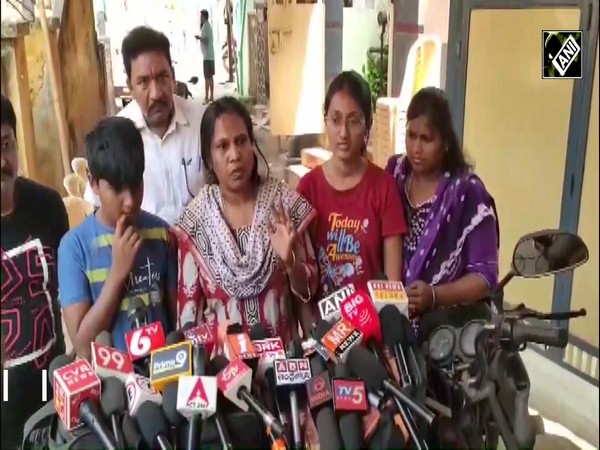
Groundbreaking Study Reveals Transformative Impact of IBDF on Consumers' Lives in Dalu Sub-division
May 09, 2025
VMPL
Dalu (Assam) [India], May 9: A recent study titled "A Study on the Impact of IBDF in Consumers' Life - Dalu Sub-division", conducted by Lavanya Joshi in collaboration with Dr. Karuna Sharad Kamble, has shed light on the significant influence of IBDF on consumer behavior, economic growth, and overall quality of life in the region. This comprehensive research highlights key trends and findings that offer invaluable insights for policymakers, businesses, and stakeholders.
The impact report presents a comprehensive study of the Input-Based Distribution Franchisee
(IBDF) model implemented by Sai Computers Limited (SCL) in the Dalu Sub-Division of Meghalaya. SCL, a prominent utility service provider with over four decades of experience, has served as the Distribution Franchisee for Meghalaya Power Distribution Corporation Limited (MePDCL) since April 2019. The report assesses the model's effectiveness in improving power distribution, enhancing consumer services, and driving regional development.
Before IBDF, Dalu residents received electricity for less than two-thirds of the day, often facing long outages and delayed repairs. After IBDF, power availability surged to nearly an entire day with faster restoration and modernized infrastructure. This shift resulted in a 70% reduction in outage duration and a dramatic drop in AT&C losses--from 87.89% in 2018-19 to 16.93% in 2023-24.
Key Findings of the Study:
* Economic Empowerment: The IBDF has played a pivotal role in boosting income generation, particularly among small businesses and local entrepreneurs in Dalu. IBDF initiatives increased small business income by up to 35% in three years, driven by efficient billing and expanded consumer reach. Reliable electricity also strengthened healthcare and education, enabling uninterrupted services, safer deliveries, and improved learning environments.
* Healthcare Impact: With close to 24 hours of power supply, emergency services now operate reliably with life-saving equipment like oxygen concentrators and diagnostics. This consistent electricity reduced emergency response delays by over 70%, significantly improving patient care and outcomes.
Enhanced Market Accessibility: Consumers in the Dalu Sub-division have benefited from increased access to various products and services, improving their purchasing power and lifestyle. Improved digital access and localized services enabled rural consumers to participate in broader markets, streamlining rural-urban trade and enhancing consumer lifestyles.
* Sustainability and Growth: Over 75% of businesses reported steady growth over five years, showcasing the model's resilience in rural economies. Unlike conventional models, the IBDF model demonstrated greater financial resilience and adaptability in rural markets.
* Consumer Awareness and Digital Adoption: A notable increase in consumer awareness regarding financial literacy and digital transactions has been observed, indicating a shift toward a more technologically inclusive economy. According to the study, digital transactions in the region have grown by 60%, demonstrating a significant adaptation to modern financial tools.
* Job Creation and Skills Development: The IBDF model has played a crucial role in employment generation and workforce skill enhancement, contributing to regional economic stability. IBDF efforts created over 1,000 jobs in five years through mobile payment units, field operations, and maintenance services, building a skilled local workforce.
One of the most critical metrics, AT&C losses, saw a dramatic decline from a high of 87.89% in 2018-2019 to a low of 16.93% in 2023-2024 This reduction is indicative of effective measures to curb losses through advanced metering infrastructure, stringent loss reduction strategies, and diligent revenue collection practices. This dramatic improvement stands as a major achievement, showcasing the model's effectiveness in enhancing efficiency and ensuring sustainable power distribution.
Tech integration through AI-powered photo analysis, spot billing, and smart metering enhanced billing accuracy and operational efficiency. These innovations, combined with 24/7 helplines and seamless online payments, elevated consumer satisfaction. The 5'S strategy--Samvaad, Samasya, Samadhan, Suvidha, Sudhaar--further improved engagement, issue resolution, and service delivery, thus providing better, faster, and more consumer-centric utility services.
Broader Implications of the Study
The Dalu model underscores the potential of IBDF, as a form of partial privatization, to bridge rural-urban disparities. By empowering local economies, integrating technology, and promoting sustainable practices, IBDF offers a scalable blueprint for rural transformation across India.
The findings of this study highlight not just the immediate impact of IBDF on consumers but also the long-term economic benefits that such frameworks provide. The study emphasizes scaling consumer-centric distribution models and calls for fostering resilient business ecosystems integrated within the IBDF. Policymakers, development agencies, and financial bodies are encouraged to replicate the Dalu IBDF model to promote inclusive, tech-integrated business ecosystems and reduce rural-urban development disparities.
Furthermore, the study suggests that IBDF initiatives can serve as a blueprint for rural economic transformation. By leveraging technology, fostering entrepreneurship, and enhancing consumer awareness, the model has demonstrated its potential to bridge economic disparities and create a more balanced economic landscape.
Future Prospects and Recommendations
The study provides several recommendations for the continued success and expansion of IBDF programs:
1. Strengthening Digital Infrastructure: Policymakers and businesses must invest in expanding digital literacy programs and improving access to high-speed internet.
2. Enhancing Financial Support: Financial institutions should create specialized lending programs tailored for specialized financing for businesses operating within the IBDF can boost their scalability and financial viability.
3. Regulatory Simplification: The government should work on reducing bureaucratic hurdles and streamlining compliance procedures to motivate more micro and small enterprises to engage with the IBDF model.
4. Encouraging Entrepreneurship: The IBDF model has emphasized mentorship through structured initiatives like SAMVAAD, which focuses on grassroots communication and awareness-building to encourage local entrepreneurship.
5. Scalability of IBDF: The successful implementation in Dalu Sub-division serves as a model that can be replicated in other rural areas facing similar economic challenges.
Significance of the Study for Policy and Business Leaders
The implications of this study extend beyond the Dalu Sub-division, serving as a crucial case study for regions across India and beyond. Business leaders, government officials, and financial institutions can utilize these insights to shape more effective economic policies. By integrating IBDF operational strategies into rural financial and business planning, the model can catalyze widespread economic improvement. This study serves as a valuable reference for policymakers, business leaders, and financial institutions, offering insights into how decentralized, consumer-focused utility models can foster inclusive economic growth and systemic resilience.
This study calls for continued research and investment in business development strategies that not only enhance individual consumer experiences but also contribute to larger economic transformations.
About the Researchers:
Lavanya Joshi is a renowned researcher specializing in consumer behavior and economic impact studies. Dr. Karuna Sharad Kamble has extensive experience in business development and sustainable economic research, contributing their expertise to this groundbreaking study.
To know more about The Impact of IBDF in Consumer Life:
Email ID - lavanyajoshi@protonmail.com
Know more about The Sai Computers, Visit site: Website Link - http://www.thesaicomputers.com
Read the full research by clicking on this link: Link - https://bit.ly/ImpactReportfinal
(ADVERTORIAL DISCLAIMER: The above press release has been provided by VMPL. ANI will not be responsible in any way for the content of the same)




























